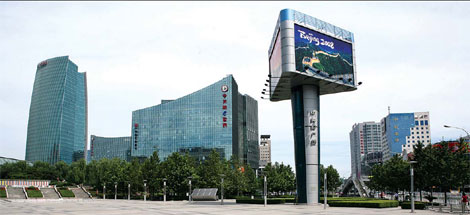Integrating financial services with innovative developments
Updated: 2011-09-16 07:47
By Han Xiao (China Daily)
|
|||||||||||
|
The local government is determined to create a sound financial service environment in the Haidian district to provide a major venue for business, conferences, finance, and related activities. Provided to China Daily |
Beijing's Haidian district is of course known for its many good universities mixed in with high-tech companies, but now it has its eyes fixed on something seemingly different - finance. It aims to build itself into a tech-financial innovation hub.
Well, perhaps not so strange. In the first half of this year, 111 more companies involved in finance moved to Haidian, bringing the total number to 1,740.
These firms had tax revenues of 27.6 billion yuan in the first six months this year, according to a district government report.
More equity firms, accounting firms, securities companies, and credit and insurance companies have got their foot in the door of this drowsy area, which has long been known for its cluster of leafy universities.
What lies behind the rapid growth in finance is a set of district government policies that favor integrating financial services with technological innovation.
One recent district government report said that the local government is determined to create a sound financial service environment in the district to make it a major venue for business, conferences, finance, and related activities.
One example of this is the district's Private Equity (PE) building, which houses 78 firms. And, in the Zhongguancun area, known as China's Silicon Valley, there are 172 financial institutions, which contributed 190 million yuan in taxes in the first half of 2011.
The district has held six finance forums so far this year, bringing together finance firms and more than 50 companies looking for capital for business expansion.
Ambitious plans
The district has said it wants to explore the possibility of setting up a regional stock exchange for companies not traded on the open market.
Meanwhile, it intends to continue encouraging businesses in Haidian and giving them help in getting listed on major exchanges, both in China and abroad, so it can eventually get that "Zhongguancun board".
In February, the district government laid out its grand vision for the Haidian of 2015: a tech-financial innovation system with a multi-layered capital market, supported by a range of financial services including PE, securities, credit, and insurance.
An even greater long-term plan, suggested in the same government document, calls for 500 PE firm with more than 500 billion yuan in their portfolio, and 300 publicly traded companies in the district.
So far, the district has managed to channel 185 million yuan worth of venture capital into 13 projects in Haidian, and is currently reviewing other finance programs submitted by nine venture capital firms.
It is also encouraging talks with PE firms to see how they can contribute to China's ambitious innovation strategy, especially for developing the Zhongguancun National Innovation Demonstration Zone.
The district government has said that it has been on a lookout for ways to get its businesses to go public and is in close contact with major stock exchanges in China and abroad. It already has an agreement with the Shenzhen Stock Exchange to jointly promote IPOs for those district businesses.
In fact, the US' NASDAQ opened a liaison office in the district this year to provide consultation. And PricewaterhouseCoopers even opened a second Beijing office in the district to provide accounting services for those interested.
(China Daily 09/16/2011 page19)
